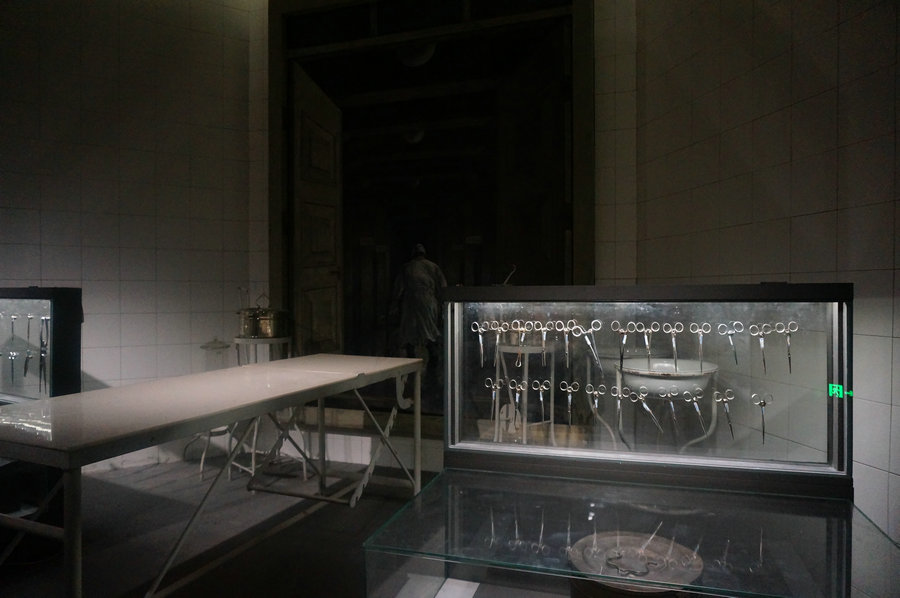Evidence confirms germ warfare and more by Japanese Unit 731

The site of Unit 731's bacterial laboratory in Harbin. [Photo/Xinhua]
Various forms of evidence including trial recordings, documents and archives reveal bacterial development, human experiments and germ warfare committed by Unit 731, a Japanese biological and chemical warfare unit during World War II.
Unit 731, a top-secret biological and chemical warfare research base established in Harbin, Northeast China's Heilongjiang province, was the nerve center of Japanese biological warfare in China and Southeast Asia during WWII.
At least 3,000 people were used for human experiments by Unit 731, and more than 300,000 people in China were killed by Japan's biological weapons.
Trial recordings confirm establishment of germ warfare system
In 1949, 12 members of the Japanese Kwantung Army were tried as war criminals in the Russian Far Eastern city of Khabarovsk for manufacturing and using biological weapons and carrying out inhuman medical experiments during WWII.
The recordings of the Khabarovsk War Crimes Trials, lasting 22 hours, 5 minutes and 57 seconds, contain contents concerning the transformation and organization of Unit 731, as well as the live human experiments, field toxicity tests, preparation and implementation of germ warfare by Unit 731.
From 1946 to November 1948, during the Tokyo Trial, the United States and Japan reached a secret deal, in which the United States obtained data on human experiments, bacteria experiments, germ warfare and gas experiments conducted by Unit 731 on the condition that the unit members were exempted from their war responsibilities. As a result, the Japanese germ war criminals escaped the Tokyo Trial.
According to Jiao Hongshuang, chief expert of a research team, the Soviet Union repeatedly demanded the extradition of Japanese germ war criminals before December 1949, but it proved futile. As a result, it conducted the Khabarovsk War Crimes Trials from Dec 25-30, 1949.

Japan's biological warfare tests and experiments on live humans and vivisections. [Photo/chinadaily.com.cn]
"The trials revealed for the first time the crimes of human experimentation and germ warfare committed by the Japanese army in Northeast China during its invasion," Jiao said, adding that the recordings also confirmed the establishment of the germ warfare system centered on Unit 731 was a top-down organized war crime committed by the Japanese state.
Commander's confessions on human experiments and bacterial warfa

The site of Unit 731's Frostbite Laboratory in Harbin. [Photo/Xinhua]
Masaji Kitano, a second commander of the Japanese Army Unit 731, wrote his confessions of the human experiments and bacterial warfare conducted by Unit 731 in China to investigators of Fort Detrick of the US Army, after he was extradited to Japan by the United States in 1946.
The United States extradited Kitano from a prison camp in Shanghai to obtain core secrets of Unit 731.
Kitano served as the second commander of Unit 731 from Aug 3, 1942 to March 1, 1945, during which he led the unit's human experiments, conducted large-scale research and development in the field of biological warfare, and sped up the manufacturing of germ weapons.
The 17-page copy of the confessions was released in Northeast China's Heilongjiang province on Aug 15, 2021.
Kitano's confessions include five aspects of content, including Unit 731's founder Shiro Ishii, its missions, composition, study and germ warfare weapons. The original copy is now stored in the National Archives of the United States.
According to a report by the US investigators, Kitano admitted in the interrogation that Unit 731 conducted human experiments, though in academic papers published during the war, Kitano said monkeys were used in the experiments.
After obtaining the material, the US Army accelerated its development of biological weapons in Fort Detrick and pardoned major members of Unit 731, irrespective of their crimes against humanity.
Core archives disclose personnel information of Unit 731

Evidence shows Japanese conducting bacteria tests on live humans. [Photo/chinadaily.com.cn]
An archival collection of over 1,400 pages based on original documents discloses the general sizes, ranks, personnel composition and other details of the notorious Unit 731 and its branch Unit 1885.
The collection unveils "the full picture of this demonic army", according to Yang Yanjun, a researcher at the Exhibition Hall of Evidences of Crime Committed by Unit 731 of the Japanese Imperial Army in Harbin.
Previous academic works involving Unit 731 mostly focused on issues such as wartime crimes, war responsibility and post-war damage. However, they often ignored basic historical facts of the unit itself, which were exactly the core supporting points of these issues, Yang noted.
Most of the personnel information of Unit 731 was disclosed for the first time, which offers key evidence to Japan's biological warfare.
Member names of germ warfare unit disclosed

Evidence of Unit 731's atrocity is on display in Harbin. [Photo/Xinhua]
The names of 468 members of OKA 9420, a Japanese germ warfare unit during World War II, have been disclosed by a Chinese museum.
OKA 9420, known to be a branch of the notorious Unit 731, took part in Japanese germ warfare in Southwest China's Yunnan province in 1942.
The list of names, which also includes the unit members' dates of birth, nationalities, close relatives and army service records, was obtained from the Ibaraki branch of the National Diet Library, Japan.
"The disclosure of the list has academic and historical value for drawing a complete picture of OKA 9420, especially its size, structure, organization, membership and the commission and location of its major crimes," said Jin Chengmin, curator of the Museum of Evidence of War Crimes by the Japanese Army Unit 731.
Video reveals operation of Unit 731 branch in Singapore during WWII
Video footage, shot by a Japanese officer who had been dispatched to Singapore from 1942 to 1943 to supervise the work of the OKA 9420, shows the Japanese army's biological warfare branch during World War II in Singapore.
Japanese personnel wearing white laboratory coats were seen working at the local college of medicine building in the Outram Park in Central Singapore.
Japanese researcher Fuyoko Nishisato, who wrote the book "Behind Bayonets and Barbed Wire: the Secrets of Japanese Army Unit 731", found and made the video public with the help of the Singaporean history buff Lim Shao Bin.
While investigating his grandfather's death in the war, Lim also uncovered other documents on OKA 9420. Among them is a 200-page medical publication and a wartime staff register.
Dated December 1942 to August 1943, the Southern Army Epidemic Prevention and Water Supply Department Research Report, Volume C, appears to be the first written evidence on the diseases the OKA 9420 was studying.
The wartime register shows OKA 9420 started with 146 Japanese staff members in May 1942. By Jan 1, 1945, its operations in Singapore and the region had grown to 862. Among them were doctors, virus specialists and nurses.
National University of Singapore professor Brian Farrell said: "These documents suggest the Japanese army institution's focus on biological warfare is perhaps more widespread than we have been led to believe through Japanese accounts."
Photos
Related Stories
Copyright © 2022 People's Daily Online. All Rights Reserved.









